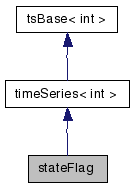stateFlag Class Reference
[Data segmentation]
an integer timeSeries for temporal segmentation of experimental data More...
#include <stateFlag.h>
Inherits timeSeries< int >.

Classes | |
| class | iterator |
| iterates over edges in a stateFlag More... | |
Public Member Functions | |
| stateFlag (std::string varnam, dataFile &df) | |
| template<class T > | |
| stateFlag (const char *vn, const char *sn, timeSeries< T > &ts) | |
| template<class T > | |
| stateFlag (const timeSeries< T > ts) | |
| stateFlag | range (int beg, int end) |
| stateFlag | range (double t0, double tf) |
| stateFlag | range (state &s) |
| std::vector< int > | rising () const |
| std::vector< int > | falling () const |
| std::vector< state > | findStates (const transition &tbegin, const transition &tend) const |
| std::vector< state > | findStates () const |
| template<class C > | |
| iterator< C > | begin () |
| template<class C > | |
| iterator< C > | end () |
Friends | |
| class | timeSeries |
Detailed Description
an integer timeSeries for temporal segmentation of experimental data
A stateFlag object contains discrete data that is used to delineate specific sections of a experiment for analysis.
See the main documentation page for detailed information about how to use the stateFlag class.
- Examples:
-
camp_utilities.h, campVIRTTEXAnalysis.cpp, hmi04.cpp, hmi04.h, hmi04_utilities.cpp, and hmi04_utilities.h.
Constructor & Destructor Documentation
| stateFlag::stateFlag | ( | std::string | varnam, | |
| dataFile & | df | |||
| ) | [inline] |
stateFlag constructor
- Parameters:
-
varnam a string that selects the field contained in the dataFile containing the stateFlag df a dataFile object that contains the data on which the stateFlag will be based
The named field must be an integer or an exception (BadType) will occur at runtime
- Exceptions:
-
BadType
| stateFlag::stateFlag | ( | const char * | vn, | |
| const char * | sn, | |||
| timeSeries< T > & | ts | |||
| ) | [inline] |
| stateFlag::stateFlag | ( | const timeSeries< T > | ts | ) | [inline] |
stateFlag constructor
- Parameters:
-
ts the timeSeries object from which the stateFlag will be derived
In this form of the constructor, the stateFlag names are implicitly generated from the existing timeSeries names by appending "<FLAG>" or "<F>" for the long name and short name respectively.
Member Function Documentation
| iterator<C> stateFlag::begin | ( | ) | [inline] |
first edge
- Returns:
- returns a stateFlag::iterator that points the first edge in stateFlag that matches the edge comparator C
- Examples:
- campVIRTTEXAnalysis.cpp, and hmi04.cpp.
| iterator<C> stateFlag::end | ( | ) | [inline] |
last edge
- Returns:
- returns a stateFlag::iterator that points the last edge in stateFlag that matches the edge comparator C
- Examples:
- campVIRTTEXAnalysis.cpp, and hmi04.cpp.
| std::vector<int> stateFlag::falling | ( | ) | const [inline] |
find location of falling edges
- Returns:
- returns a vector of int's containing the location of every falling edge
| std::vector<state> stateFlag::findStates | ( | ) | const [inline] |
| std::vector<state> stateFlag::findStates | ( | const transition & | tbegin, | |
| const transition & | tend | |||
| ) | const [inline] |
find states contained within a stateFlag object
- Parameters:
-
tbegin a transition object that matches the beginning of the state tend a transition object that matches the end of the state
- Returns:
- returns a vector of states contained within the stateFlag that begin with transition tbegin and end with transition tend
- Examples:
- hmi04.cpp.
- Parameters:
-
s state
- Returns:
- a timeSeries object formed from the subrange defined by the state s
States are simply pairs of indices that define a region. They usually arise from searches on stateFlag objects. Subranges are created by reference. No data is copied or moved.
Reimplemented from timeSeries< int >.
| stateFlag stateFlag::range | ( | double | t0, | |
| double | tf | |||
| ) | [inline] |
- Parameters:
-
t0 begining time tf ending time
- Returns:
- a timeSeries object corresponding approximately to the range [t0,tf]. If t0 or tf do not correspond exactly to a sample time, the nearest sample is used.
Subranges are created by reference. No data is copied or moved.
Reimplemented from timeSeries< int >.
| stateFlag stateFlag::range | ( | int | j, | |
| int | k | |||
| ) | [inline] |
- Parameters:
-
j begining sample k ending sample
- Returns:
- a timeSeries object corresponding to the range [j,k]
Subranges are created by reference. No data is copied or moved.
Reimplemented from timeSeries< int >.
- Examples:
- hmi04.cpp.
| std::vector<int> stateFlag::rising | ( | ) | const [inline] |
find location of rising edges
- Returns:
- returns a vector of int's containing the location of every rising edge
- Examples:
- hmi04.cpp.
 1.6.3
1.6.3